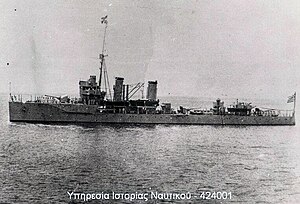Greek cruiser Elli (1912)

Elli - Εύδρομον Έλλη
|
|
| History | |
|---|---|
|
|
|
| Name: | Elli |
| Namesake: | Naval Battle of Elli |
| Builder: | New York Shipbuilding |
| Laid down: | 14 June 1911 |
| Launched: | 4 May 1912 |
| Completed: | November 1913 |
| Commissioned: | 1914 |
| Fate: | Sunk 15 August 1940 off Tinos harbour |
| Notes: | Previously CNS Fei Hung |
| General characteristics | |
| Class and type: | Chao Ho-class protected cruiser |
| Displacement: |
|
| Length: | 98 m (321 ft 6 in) |
| Beam: | 12 m (39 ft 4 in) |
| Draft: | 4.3 m (14 ft 1 in) |
| Propulsion: | 3 propellers |
| Speed: |
|
| Complement: | 238 |
| Armament: |
|
| Armour: | Unknown |
Elli (Greek: Κ/Δ Έλλη) was a 2,600 ton Greek protected cruiser (Greek: Εύδρομο Καταδρομικό) named for a naval battle of the First Balkan War in which Greece was victorious. She was completed in 1913 and commissioned in 1914. Elli saw action during World War I and in the disastrous Asia Minor Expedition. An Italian submarine sank her, before the outbreak of the Greco-Italian War on 15 August 1940 while she sat at anchor.
She was originally one of three cruisers of the ill-fated Chao Ho class. The Chinese government ordered her built as the Fei Hung (Chinese: 飞鸿; pinyin: Fēi Hóng; literally: "Flying Swan"), however, the Nationalist revolution in 1912–13 resulted in the Chinese government cancelling the purchase. New York Shipbuilding in the United States completed her in 1914 and sold her to Greece, which purchased her as part of its program of naval expansion after the Balkan Wars.
Elli saw action during World War I. Initially during the war, Greece followed a course of neutrality, with the Prime Minister Eleftherios Venizelos favoring the Entente and pro-German King Constantine I advocating neutrality. This dispute eventually led to a deep political conflict, known as the "National Schism". In November 1916, in order to apply pressure on the royal government in Athens, the French confiscated the Greek ships. They continued to operate with French crews, primarily in convoy escort and patrol duties in the Aegean, until Greece entered the war on the side of the Allies in June 1917, at which point they were returned to Greece. Subsequently, the Greek Navy took part in the Allied operations in the Aegean.
...
Wikipedia
